 |
|
Lieutenant-Colonel Thomas
Thorneycroft
of Tettenhall Towers
by Bev Parker |
|
|
 |
|
Tettenhall has long been a much
sought-after location in which to live. For many years it
has attracted wealthy industrialists and businessmen and
their families. Some of them had large houses built in large
grounds with ornate gardens. One of the well-remembered
local industrialists is Lieutenant-Colonel Thomas
Thorneycroft, D.L., J.P. who purchased Tettenhall Towers in
Wood Road and became a leading member of local society. He
was well known for his eccentric way of life, his
inventions, and his support of local charities.
Family background
The Thorneycroft family (originally
Thornicroft) originated in Cheshire in the 13th century. In
the 1660s John and Katherine Thornicroft moved to Broseley,
Shropshire, where their son John was born in 1663. John’s
grandson, Edward Thorneycroft married Mary Bradley, and they
had a daughter, Maria, born in 1787. Around 1790 they moved
to Tipton, Staffordshire, where Edward became landlord of
the ‘Three Furnaces’ public house. Their next two children,
twin boys, Edward Charles, and George Benjamin, were born
there on 20th August, 1791.
The family moved to Kirkstall, Leeds,
where Edward senior worked at Kirkstall Forge. His twin sons
began their working life there and attended evening classes
to learn about iron manufacture. |
|
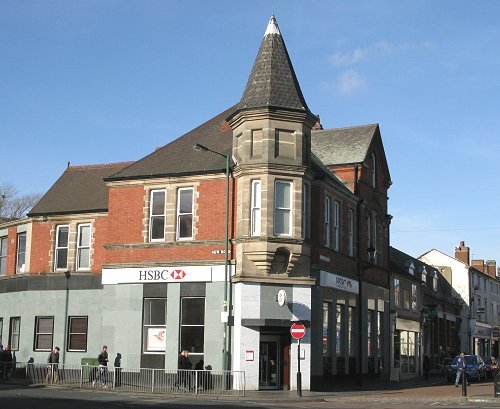
The site of the family's cottage
in Willenhall. |
In 1809, at the age of 18, the two
brothers returned to Staffordshire. George became an
iron puddler at Addenbrooke’s Moorcroft Ironworks at
Bradley, and soon discovered a method of producing
better quality iron at a cheaper price.
He married Eleanor Page, who lived
at Moxley and in 1817 opened a small ironworks at Forge
Yard, Waterglade Street, Willenhall.
The family lived in a small cottage
on the corner of New Road and Market Place, Willenhall,
where the ex-HSBC bank building now stands. |
By the mid 1820s the family had moved to a large
house in Tettenhall Road, Wolverhampton, called
Chapel House. They had nine children:
| |
|
| Ann |
born in Willenhall in
1816, died in 1822. |
|
Mary |
born in
Willenhall in 1818. |
| John
|
born in Willenhall in
1820, died young. |
| Emma |
born in Willenhall in
1821. |
| Thomas |
born in Willenhall in
1822. |
| Ann Maria |
born in Wolverhampton
in 1825, died 1836. |
| Harriet |
born in Wolverhampton
in 1827. |
| Ellen |
born in Wolverhampton
in 1830. |
| Hannah |
born in Wolverhampton
in 1833, died young. |
| |
|
|
|

Chapel House. |
|
Chapel House was soon extended. A
wing was added on either side of the house, which was
divided into two to form Granville House and Salisbury
House. As the children got older, George built
‘Summerfield’ in the grounds of Chapel House as a home
for Mary. After her marriage, Emma and Ellen began their
married life there. The four surviving girls married men
who became prominent in the town.
Mary married Charles Corser, a
Wolverhampton solicitor. Emma married John Hartley who
owned Hartley's Glassworks in Sunderland and became a
partner in Chance Glass Works, Smethwick. He was also a
partner George Thorneycroft’s business and became a very
wealthy man. In 1858 John and Emma leased Tong Castle
from the Earl of Bradford, and until his death in 1884,
Hartley was referred to as the Squire.
Harriet married Charles Perry, the
eldest son of Thomas Perry, who founded Thomas Perry &
Son Limited at Highfield Works, Bilston. Ellen married
Henry Hartley Fowler, a solicitor who became mayor of
Wolverhampton in 1862/3. In 1880 he became a Liberal
member of parliament for Wolverhampton, a post he held
until 1908 when he was raised to the peerage as Viscount
Wolverhampton.
Thomas, the most well-known of the
children, married Jane Whitelaw and became a wealthy
industrialist, a landowner, a prominent Conservative and
a Justice of the Peace. |
|
In 1824, George and his brother
Edward established the Shrubbery Iron Works, in Lower
Walsall Street, Wolverhampton. The venture was a great
success and George became a wealthy man. Within a few
years, between 600 and 700 tons of high quality iron
were produced each week. After several years, Edward
left the partnership and George ran the ironworks under
the name of G.B. Thorneycroft & Company.
In 1845 George Thorneycroft was
seriously injured in an accident at one of his pits in
Willenhall. A new pumping engine was being tested when a
faulty safety valve led to a boiler explosion. One man
was killed and sixteen others, including George, were
injured. He was scalded over the whole of his body and
never completely recovered. George became
Wolverhampton’s first mayor after the town’s
incorporation in 1848 and eagerly gave contributions to
many organisations and charities. He also founded the
Thorneycroft Benefaction which gave £1,000 for the
distribution of blankets and flannel to the poor. |
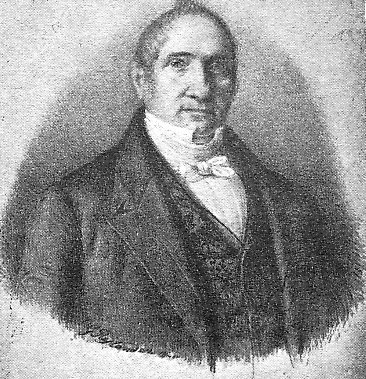
George Benjamin Thorneycroft. |
|
In the early part of 1851 George
suffered from brain disease. He initially appeared to
improve, but died after a relapse on the 28th April,
1851, at the age of 60.
He is buried in Merridale Cemetery,
where a bronzed cast-iron monument was erected to
commemorate his life. Next to the grave is a plinth on
which a colossal marble statue of George was erected. In
1871 the statue was moved to the entrance hall in the
Town Hall in North Street. Eleanor died on the 5th
January, 1874 and was buried alongside her late husband.
Their daughter Mary Corser, who died on 18th December,
1897 at the age of 80, is also buried there.
Thomas Thorneycroft
After his time at Wolverhampton
Grammar School, Thomas joined his father’s successful
business, G.B. Thorneycroft & Company and eventually
became a partner. On the 29th June, 1847, Thomas
married Jane Whitelaw at Gartsherrie House, Old Monkland,
near Glasgow. She was a wealthy Clydeside ironfounder’s
daughter.
After his father’s death in 1851,
he inherited a large sum of money and his father’s
business, which continued to be successful and grew into
a large enterprise, with many collieries, Shrubbery and
Swan Garden ironworks. G.B. Thorneycroft & Company
became the largest employer on the eastern side of
Wolverhampton. Large profits were made during the
Crimean War from the production of shells and armour
plate, and by 1873 there were 74 puddling furnaces and
12 mills and forges in the two ironworks.
A happy relationship existed
between management and staff at both factories. The
company paid higher wages than average, and was well
respected for it, but in the mid 1870s things started to
go wrong. The business began to run at a loss due to a
recession in the iron trade. After several years of
loss-making, the company closed in December 1877,
blaming the closure on the higher wages that were paid
to the workforce.
Although Thomas had a reputation
for his charitable work, he simply gave the workforce an
ultimatum, telling them to accept lower wages or the
factory would close. The workers would not agree to a
cut in wages and so after running the business for 26
years, he shut it down. It is possible that his heart
was not in the running of the firm and that this was a
golden opportunity to leave it behind. He did receive
praise from some quarters for his stand against the
workers. The Times newspaper praised his actions. The
ironworks and associated collieries were soon sold and
Thomas could now become a full-time member of the landed
gentry, with all the privileges it entails and devote
himself to his many interests. |
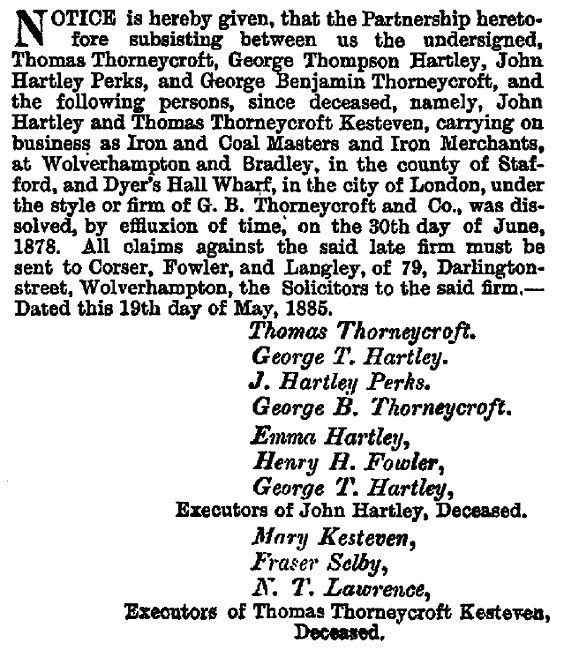 |
A notice about the final
winding-up of G. B. Thorneycroft & Company that appeared
in the London Gazette on 25th September, 1885. |
| In 1853, Thomas purchased a large Georgian country
house in Wood Road, Tettenhall, that had been built on
the site of the Holly Bush Inn and was set in 26 acres
of land. He gradually extended the house and also added
the towers, onto which he installed signalling
equipment. In 1866 the house became known as Tettenhall
Towers. Thomas converted the house into one of the most
remarkable houses in the district and filled it with
some of his unusual inventions and his many shooting
trophies. He shot almost anything that moved, especially
if it had horns and could be used to decorate walls or
embellish armchairs. Thomas was very much a family
man. He and Jane had nine children:
| |
|
| Jessie |
born in 1848 and died in
1935. |
| George
Benjamin |
born in 1849 and died in
1924. |
| James Baird |
born in 1851 and died in
1918. |
| Jeanie |
born in 1852 and died in
1925. |
| Hamo Douglas |
born in 1855 and died in
1946. |
| Eleanor |
born in 1857 and died in
1941. |
| Alexander
Whitelaw |
born in 1859 and died in
1931. |
| Wallace |
born in 1861 and died in
1954. |
| Florence |
born in 1869 and died in
1944. |
| |
|
|
|
Their most famous son was Alexander
Whitelaw Thorneycroft who served in the 21st Royal
Scotch Fusiliers and eventually rose to the rank of
Major-General.
As a Second-Lieutenant, he saw
action in Natal province, South Africa, during the Zulu
War and later in the Boer War. His troopers became known
as Thorneycroft's Mounted Infantry.
In 1899 he was promoted to
Lieutenant-Colonel. At the Battle of Spion Kop he lead
the initial assault with his dismounted troopers.
In 1903 he married Rebekah Frances
Crozier at St Marylebone, London and for his services to
King and country, he received a C.B. (Companion of the
Most Honourable Order of the Bath).
Alexander died at his residence,
Blandford Lodge, Whiteknights, Reading, Berkshire, aged
72 and was buried in the graveyard at Earley Church,
Reading, on Saturday the 7th November, 1931 in a grave
next to his late wife. |

Alexander Whitelaw Thorneycroft. |
|

Tettenhall Towers. From an old
postcard. |
|
Hobbies and
Eccentricities
Lieutenant-Colonel Thomas
Thorneycroft’s rank came from the Queen's Own Royal
Regiment of Staffordshire Yeomanry, a sort of
territorial army, in which he served. He was never a
member of the regular army. In 1855 he commanded his
troop during the miners' riots in Wolverhampton and in
1866, commanded the mounted detachment of Yeomanry, when
Queen Victoria visited the town.
Thomas owned or leased several
properties (other than Tettenhall Towers) including Tong
Castle, Pepperhill Park, Albrighton Mill, Bylet Island
in the River Severn at Bridgnorth, Gorsty Hayes, and
Hadley Park near Wellington, where he was Lord of the
Manor. |
|
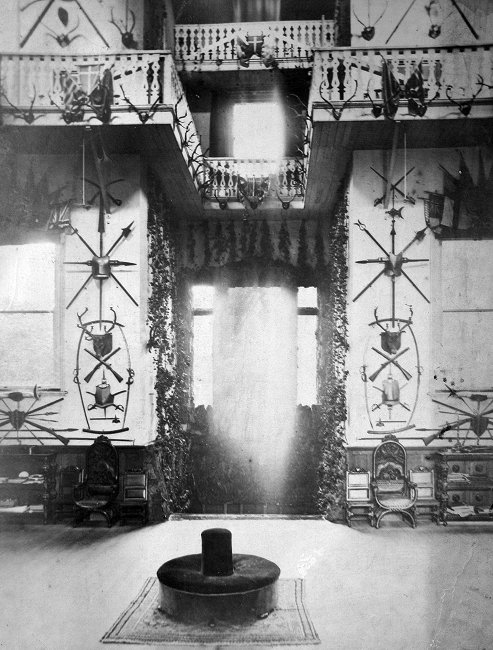
The waterfall at the back of the
stage. |
Thomas designed much of the
furniture in the house and added the great hall,
complete with a stage and seating for 500 people. It had
an auditorium, a backdrop for scenery, and a fan that
blew hot, cold, or scented air into the room.
There was also a waterfall at the
back of the stage, in which water cascaded down from a
tank that was 44 feet above the ground. The waterfall
was lit by coloured lights to create a spectacular
scene.
Another spectacular feature
consisted of a water pump that blew a jet of air into
the base of the fire in the inglenook fireplace, which
sent flames roaring up the chimney.
The theatre had a sprung oak floor,
which was ideal for dancing. Thomas loved writing poetry
and had this to say about it:
The oak floor makes
a skating rink, it's on elastic springs.
So when you dance, you're apt to think,
you're fluttering on wings’. |
| Much of the ornate wooden panelling in the theatre
was made by a local craftsman, but some sections were
purchased from Tewksbury Abbey and Ludlow Castle.
Thomas loved hunting and shot many animals for trophies,
which were displayed throughout the house.
In the theatre there were antlers, cattle horns, and
animal heads. Many of the chairs had arms that were
embellished with them.
There were also two chandeliers, with lighted gas
emerging from the points of antlers. |
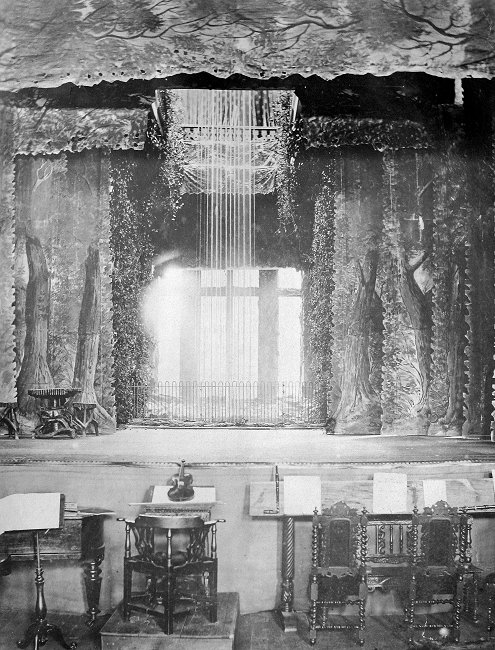
Another view of the waterfall. |
| As well as writing poetry, Thomas was a skilled
musician who played the violin and had his own band. He
composed a number of waltzes, songs, and even an opera
called the "Thorneycroft Cousins". The band gave many
public and private performances there. Thomas also gave
magic lantern shows and raised money for charities from
various performances in the theatre. |
|

The Thorneycroft band. |
|

The sock and shoe warmer. |
He was obsessed with sanitation and
ventilation. His many inventions included an elaborate
system of ventilation for the house, and a special
toilet to go with the 20 or so toilets that he had
installed in the house.
One of his inventions consisted of
a device that pumped foul air from the sewers, which was
burned at the top of a pipe, about forty feet from the
house.
There were ventilating fans in many
of the rooms and an elaborate heating system for some of
the rooms and to heat clothes.
His other inventions included a
patent for burning microbes in sewer gas, improvements
in road carriages, a steerage device for balloons, a
full-length mirror door for wardrobes, a glass umbrella
so that you could see where you were going in rainy
weather, a sock warmer on which to hang socks and shoes
to dry, a set of playing cards for the blind and a
safety bottle opener.
He also designed a battleship,
which he patented and sent a copy of the design to the
Admiralty. He installed a lift in the house and had a
racquet court and a Turkish bath built. |
|
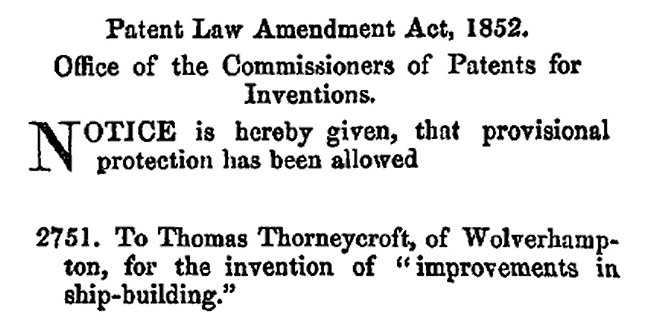
A notice about his battleship
patent that appeared in the London Gazette on 19th
January, 1855. |
|
Thomas was fascinated with
balloons. On the 11th September, 1882 he made an ascent
in a balloon called the ‘Dudley Castle’ from the grounds
of the Molineux Hotel. A flight that nearly ended in
tragedy. Thomas read an article in the Wolverhampton
Chronicle about Captain Morton who planned to visit
Wolverhampton and make an ascent in his balloon. Thomas
met him on his arrival at the railway station and begged
to join him in the flight.
On the day of the flight, the
balloon was got ready and the two of them took off as
planned. It was a terrible day with heavy rain, a day
totally unsuitable for the flight. The balloon contained
28,000 cubic feet of hydrogen gas, which of course was
highly inflammable. The balloon would not ascend as
planned and was flying just over rooftop height when it
hovered over the furnaces in a local ironworks. It was
in danger of dropping into the furnaces and exploding,
even though all of the ballast had been thrown out. In
desperation, Thomas even offered to throw out his best
top coat.
At the last minute the weather
improved, the rain stopped, the sun came out and the
balloon continued its journey, landing safely an hour
later in Smethwick. On his return home, Thomas quickly
began to design a device for steering balloons. He wrote
the following words, giving advice to fellow balloon
travellers: “Take a moderate meal two or three hours
before you go, take something to eat and drink, not
forgetting some brandy and water, some warm clothes, a
good waterproof coat or two and an umbrella. And last
though not least, don’t forget a thick, warm pair of
gloves.” |
|

George Phoenix's drawing of the
balloon and Tettenhall Towers. |
| Thomas’s life was also in danger on another
occasion. He was a passenger on board the ship “Russia”
when it struck another vessel as it steamed towards New
York harbour. The other vessel sank within five minutes,
but luckily all the people on board were saved. Thomas
travelled to many other parts of the world including
Canada, where he went salmon fishing and visited Niagara
Falls. He also liked Spain.
The towers on the house were used for communicating
with Thomas’s workers in the grounds by the use of
semaphore flags. He also invented flying machines that
were flight-tested from the top of the towers.
Thomas loved horses and designed several carriages.
He also enjoyed steeplechasing, was a member of the
Albrighton hunt and greatly enjoyed going out with the
hounds. He even wrote a hunting song. Another hobby was
boating. |
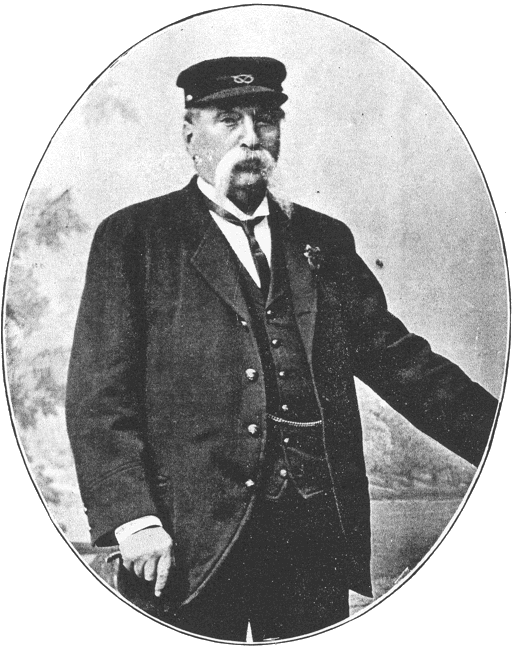
Thomas Thorneycroft. |
|

Thomas and his canal boat. |
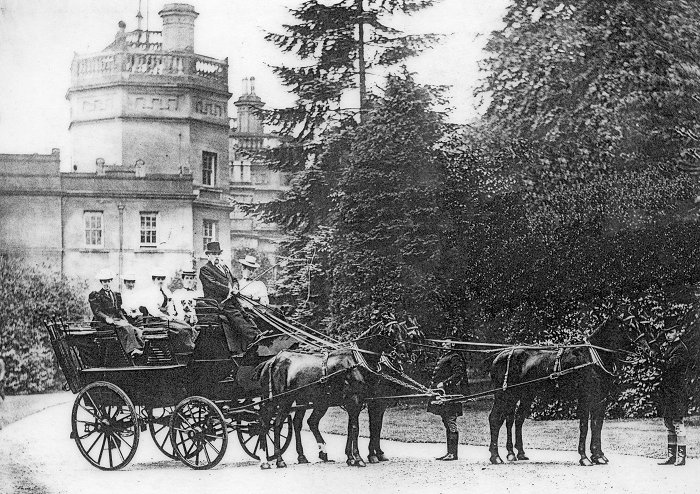
Thomas in his carriage with Miss
Flossie Campbell, Miss Fussell, Miss Eleanor
Thorneycroft, and Miss Florence Thorneycroft. |
|

Tettenhall Towers gatehouse. |
| Thomas led a busy life and supported and worked for
many good causes, including the Mining Accident Fund,
the Prisoners' Aid Society and the St. John's Ambulance
Brigade. He served as a magistrate in Wolverhampton and
Shropshire and was Sheriff of Staffordshire and Deputy
Lord Lieutenant. |
|
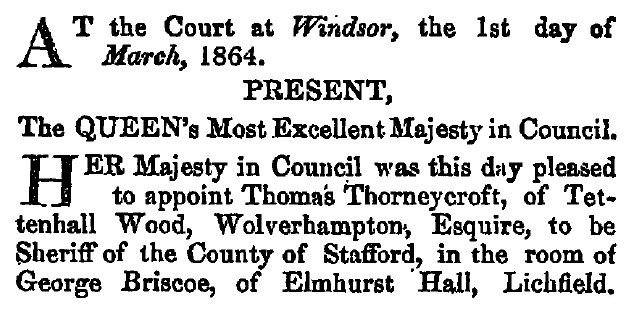
From the London Gazette, 4th
March, 1864. |
|
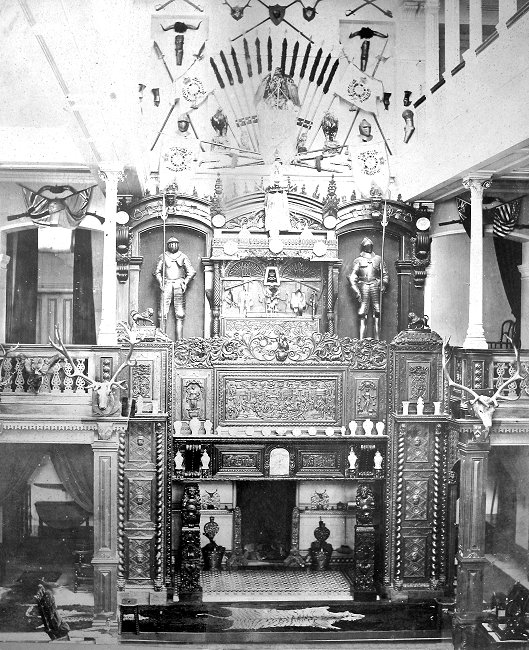
The inglenook fireplace in the
theatre. |
For many years he was Chairman of the Royal
Hospital's Board of Governors, Vice President of the
Royal Orphanage, and after the cholera outbreaks he
campaigned for an improvement to Wolverhampton’s public
health facilities. Thomas was an active member and
great supporter of the Conservative Party and Chairman
of the Kingswinford Conservative Association. Two Tory
Prime Ministers, Derby and Disraeli asked him to stand
for parliament, but he never did.
He was Ruling Councillor of the local branch of the
Primrose League, which actively encouraged support for
the Conservative Party and held meetings at the Towers.
He was also Chairman of Mr. Staveley Hill’s Election
Committee. |
| Thomas ran and equipped a company of boys from the
Boys Brigade, at his own expense, which were called the
Thorneycroft Tettenhall Company.
He also collected £2,600 for beautifying and
enlarging Tettenhall churchyard.
Much of the money was supplied by himself and the
family and from various performances in his theatre. |

The theatre, seen from the stage. |
|

Thomas. |
In 1889 Thomas and Jane celebrated their golden
wedding anniversary along with their son Alexander, who
had just returned from the South African War.
Bunting was hung in Tettenhall High Street and a
‘Welcome Home’ sign was placed over the entrance gate to
the Towers. |
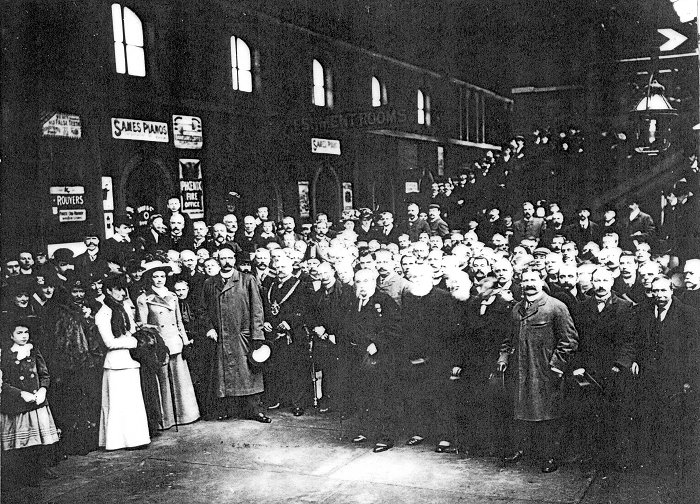
Alexander Whitelaw Thorneycroft's
arrival at Wolverhampton Low Level station on his return
from the South African War. |
|

A Thorneycroft family group. |
|
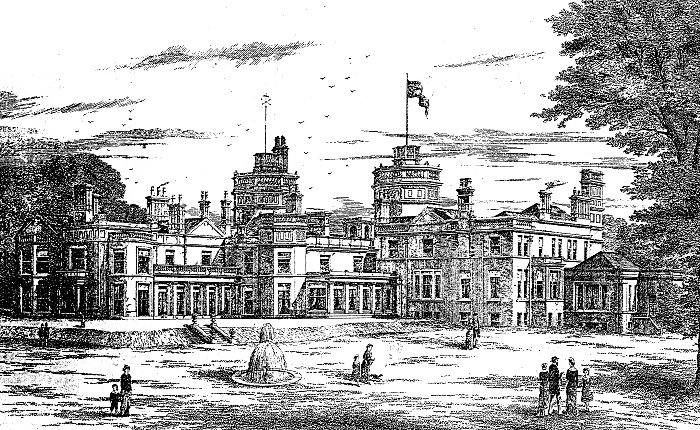
Tettenhall Towers. |
|
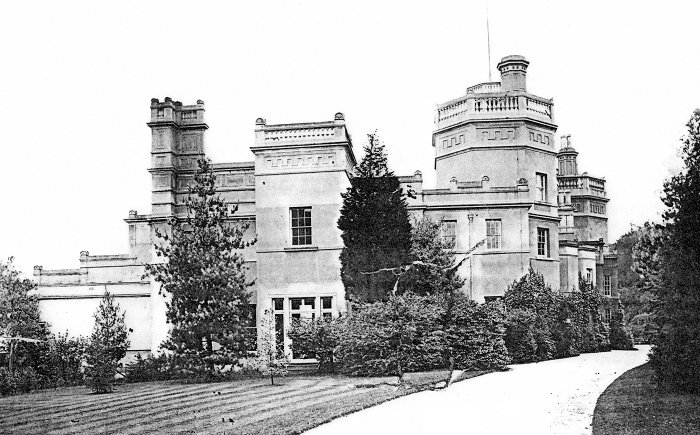
Another view of Tettenhall Towers. |
|
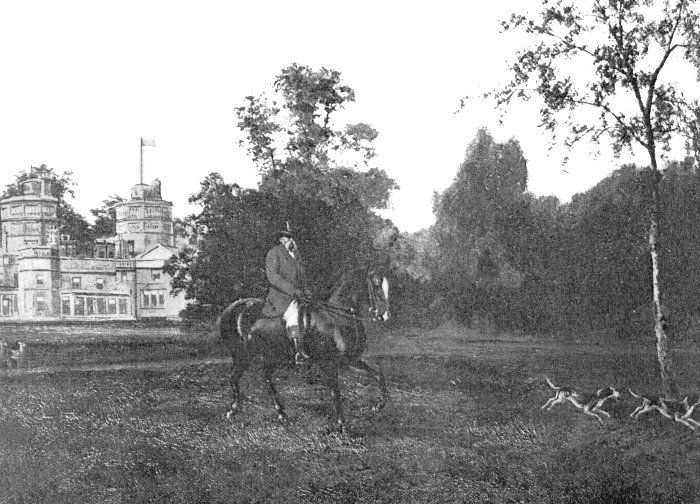
Thomas riding his favourite mare,
called The Grand Duchess. |
|

The stables at Tettenhall Towers. |
|
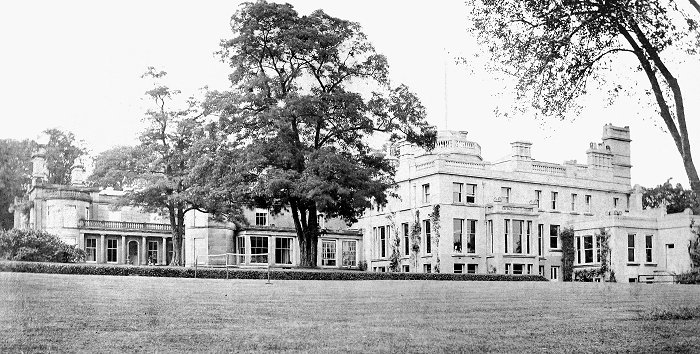
The back of Tettenhall Towers. |
|
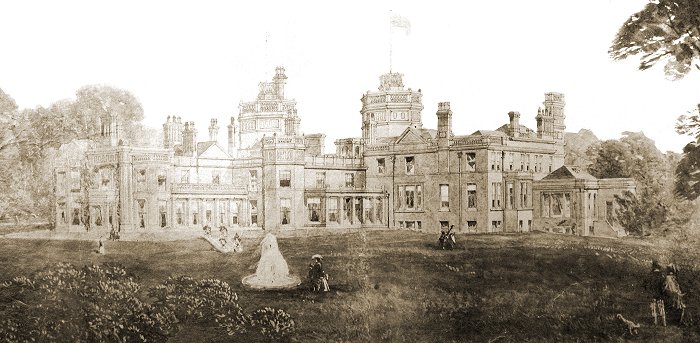
A final view of Tettenhall Towers. |
|
Thomas’s Death
In 1902 he visited the
Wolverhampton Art and Industrial Exhibition and was
fascinated by the great water chute in which boats were
hauled to the top of an inclined plane, before
plummeting downwards into the lake. He had to try it out
for himself. On this occasion the boat hit the water
slightly askew, and Thomas was thrown heavily against
the side of the boat. He was badly shaken and became
very ill. |
|
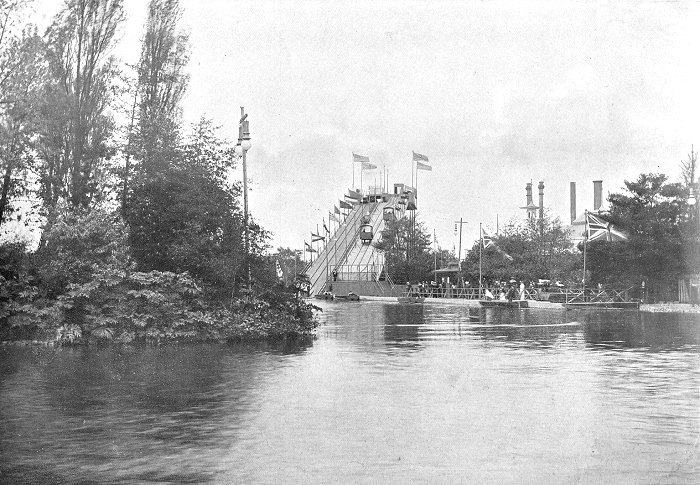
The water chute at the
Wolverhampton Art and Industrial Exhibition. |
|
He never recovered from the illness
and died at home on the 6th February, 1903.
His funeral was held at St. Michael
and All Angels Church in Tettenhall, on Tuesday, the
10th February.
Large crowds gathered to watch the
procession as it made its way down The Rock to the
church, in what must have been one of Tettenhall’s most
impressive funerals. He is buried in the graveyard at
the church.
His wife died on the 29th
September, 1908 at home and was buried alongside her
husband, as was their daughter Eleanor, who died on 17th
November, 1941.
|

Thomas's grave at St. Michael and
All Angels graveyard in Tettenhall. He is buried with
his wife Jane and daughter Eleanor. |
|
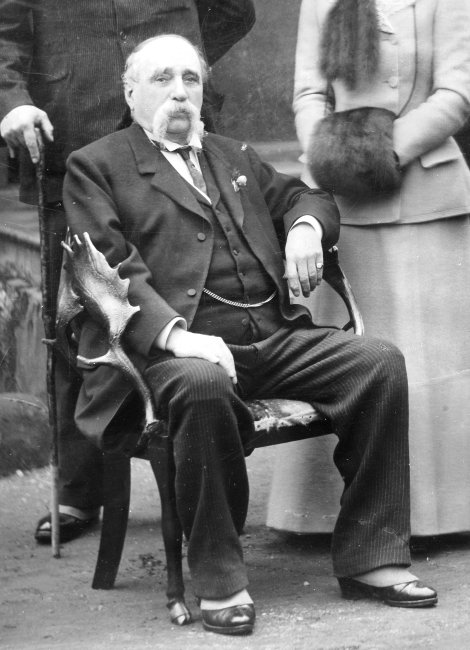
Thomas, seated in a chair
decorated with some of his trophies. |
Lieutenant-Colonel Thomas
Thorneycroft is well-remembered in Tettenhall, mainly
because of his eccentricities and inventions. His
generosity to many institutions and good causes is often
forgotten.
Many tales were told about him,
some possibly true, others possibly untrue. The stories
will keep his name alive in the village for many years
to come.
His name can now be seen again in
Wood Road were a number of apartments have been built
for the over 70s under the name ‘Thorneycroft’.
Tettenhall Towers was purchased by
Tettenhall College in 1943. On the 29th July, 1950 it
was Grade II* listed.
|
| During the First World War, Florence
Thorneycroft became Matron, in charge of the
Voluntary Aid Detachment Hospital at The Old Manor
House, Old Hill, Tettenhall. It was a Red Cross
auxiliary home hospital that looked after wounded
soldiers.
Florence helped with fundraising and encouraged
donations to keep the hospital running.
|

Florence Thorneycroft. From a
copy of a miniature painted by Margaret Edwards. Courtesy of David Parsons. |
|
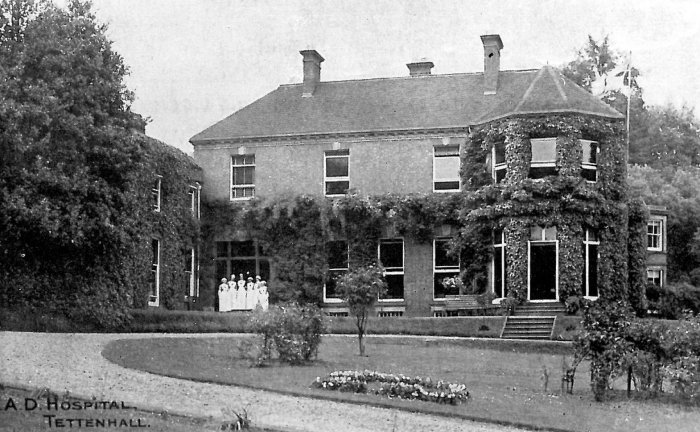
The Old Manor House. From an
old postcard, Courtesy of David Parsons. |
|

The back of the postcard.
Courtesy of David Parsons. |
|
Thomas’s Inventions:
|
1. |
Application of a stream of air to blow
up large sitting-room or hall fires in
houses. |
|
2. |
Elastic dancing floors. |
|
3.
|
Burning sewer gas (in which microbes are
found to exist), at a temperature of 400
degrees. |
|
4.
|
Cascades, as applied to his theatre. |
|
5. |
Windows at the back of the stage in his
theatre, thereby utilising one or two acres
for a stage on his pleasure grounds, where
river scenes and forests are arranged almost
naturally, with lime, electric, and Bengal
lights; real water is also used in these
scenes, the cascade having a drop of 44ft. |
|
6. |
Apparatus for warming clothes, boots,
awl shoes in his dressing-room, which
apparatus runs through his boot-case, thus
keeping these articles of clothing in good
condition. |
|
7. |
Washing stand and dressing table in one. |
|
8.
|
New roof for racquet court, where there
are also Turkish, swimming, and saltwater
baths. |
|
9. |
New water closet, where the lid lifts
up, thus making it into a urinal. |
|
10. |
New hot water and gas stove for his
business room, which also warms shoes,
boots, and socks. |
|
11. |
Two mechanical horses trotting, with
carriage behind. |
|
12. |
New glass door wardrobe invented in 1846
(the year before he married), and now used
in nearly all countries. |
|
13. |
New corkscrew box for ladies' use, there
being no danger of the cork bursting. |
|
l4. |
A warship made of bar iron, each side,
with wood in the middle, so that at most
cannon balls can only make a small hole,
which can easily be plugged up. |
|
15. |
A new apparatus that can steer a balloon
to the extent of 250 yards in a drop of a
mile, the idea being to avoid falling on
trees or houses. This was invented by
Colonel Thorneycroft after his experience of
ballooning on the 11th September, 1882. |
|
16. |
New mangers, to contain a supply of hot
or cold water. |
|
17. |
New Victoria-Clarence carriage. When
open no glass can be seen; when shut it
resembles a perfect Clarence. |
|
18. |
New hansom brougham, invented in 1867.
Now regularly used as a Court brougham. |
|
19. |
A new charabanc, where a small brougham
can be arranged behind the driver, if wet,
and another sort of mail phaeton hood fitted
up in two minutes behind. A staircase is
also fitted to this carriage, so that ladies
can get up safely and easily if the carriage
is on the move. |
|
20. |
An alteration in the stage coach, where
the last seat but one is turned round, and
an opening thus made in the roof for the
legs, so that passengers ride facing the
horses when they wish. Can be altered into
its old state in two minutes. Also a set of
steps for ladies to get up inside the
coaches. A glass window fits in the front
boot, so that the inside of the coach really
forms a comfortable Court brougham, in which
the view of the horses is not interrupted,
while a good view of the country beyond can
also be enjoyed. |
|
21. |
Picnic wagon where 14 can dine
comfortably. Under some canvas wings more
can dine. Often used with three cobs
abreast. |
|
22. |
A small ash shovel, made of wire, to
preserve the small ashes, yet allowing the
dust to fall through, thus affecting a great
saving in coals. |
|
23. |
A new ballroom for moderate sized houses
in London or elsewhere, on carriage wheels.
Can be enlarged at pleasure, put up in the
street in front of the houses in two hours,
and taken down in two hours, only covering
the area, footpath, and 10 feet of the
street. It is necessary to obtain permission
to use this. Usual size 50 by 20ft. |
|
24. |
A fire escape of network on wheels. can
be placed in front of houses on fire, for
people to jump into, or be thrown into
safety. Above 100ft. high. |
|
25. |
A house canal boat, with a new sort of
deck; a 72ft. long boat with deck, dining,
bandsmen's rooms and kitchen, as well as two
cabins. Gas is used from cylinders to cook
and warm the rooms. |
|
26. |
A brake that horses can, and do work
themselves when going downhill, and take off
when going along the level road or uphill.
It applies to a one-horse cart or a
pair-horse carriage or coach. |
|
27. |
A galvanised thin sheet of steel in boot
and shoe soles, to keep feet dry and warm,
as no wet can get through. |
|
28. |
A galloping horse, life size, on a magic
lantern slide, with jockey. |
|
29.
|
Composed 16 songs, words and music, one
march, two waltzes; all the words and parts
of the music of an opera called the
"Thorneycroft Cousins," which was performed
for three nights at Tettenhall 'rowers,
before 1,400 people. |
| |
|
|
 |
Return to the
previous page |
|
|